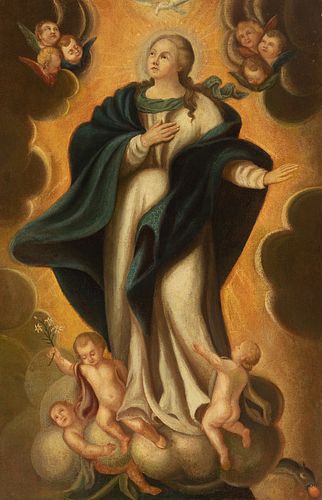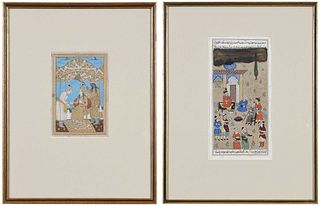Spanish school; second half of the XVIII century. "Immaculate Conception". Oil on canvas. Relined.
Lot 66
About Seller
Setdart Auction House
Carrer Aragó 346
Barcelona
Spain
Setdart Subastas was born in 2004 and is currently the first online art auction in Spain with solidity, prestige and reliability guaranteed by our more than 60,000 users. Setdart has a young, dynamic and enterprising team ready to successfully manage the purchase and sale of art works through custom...Read more
Estimate:
EUR€1,800 - EUR€2,000
$1,875 - $2,083.33
Absentee vs Live bid
Two ways to bid:
- Leave a max absentee bid and the platform will bid on your behalf up to your maximum bid during the live auction.
- Bid live during the auction and your bids will be submitted real-time to the auctioneer.
Bid Increments
| Price | Bid Increment |
|---|---|
| EUR€0 | EUR€10 |
| EUR€200 | EUR€25 |
| EUR€500 | EUR€50 |
| EUR€1,000 | EUR€100 |
| EUR€3,000 | EUR€200 |
| EUR€5,000 | EUR€500 |
| EUR€10,000 | EUR€1,000 |
| EUR€20,000 | EUR€2,000 |
| EUR€50,000 | EUR€5,000 |
About Auction
By Setdart Auction House
Nov 3, 2021
Set Reminder
2021-11-03 08:00:00
2021-11-03 08:00:00
America/New_York
Bidsquare
Bidsquare : OLD MASTERS
https://www.bidsquare.com/auctions/setdart-auction-house/old-masters-7786
Setdart Auction House sofia@setdart.com
Setdart Auction House sofia@setdart.com
- Lot Description
Spanish school; second half of the XVIII century. "Immaculate Conception". Oil on canvas. Relined. It has a Carlos IV style frame. Measurements: 127 x 83 cm; 136 x 92 cm (frame). Inscribed in a golden break of Glory, the figure of the Virgin is arranged as the Immaculate Conception. Located on a pedestal created by clouds to which three small angels cling, stands the figure of the Virgin standing, monumental. She is facing the viewer, however, she raises her face and slightly shifts it to the left, seeing something that is outside the pictorial composition. Despite this, her serene face and pious attitude with one hand on her chest indicate that she is addressing God, establishing direct contact with him and not with the viewer. A spectator to whom she is presented in a regal way, thanks to her preponderant situation in the composition, her bearing and the monumentality of the forms, placed under the representation of the Holy Spirit, as queen of heaven and of Christianity. It should be noted that the work follows the iconographic patterns imposed during the baroque period, however, in this work the author dispenses with the litanies and some of the Marian symbols, leaving only in sight; the snake with the apple that symbolizes sin and the flower known as Tears of the Virgin, which represents the purity of the Virgin. Medieval Christianity passionately debated the belief that Mary had been conceived without stain of original sin. Some universities and corporations vowed to defend this privilege of the Mother of God, several centuries before the First Vatican Council defined the dogma of faith in 1854. At the end of the Middle Ages the need to give iconographic form to this idea was born, and the model of the Apocalyptic Woman of St. John was taken, maintaining some elements and modifying others (the Apocalyptic Woman is pregnant, but not the Immaculate). The definitive image came to fruition in the 16th century, apparently in Spain. Following a Valencian tradition, the Jesuit Father Alberro had a vision of the Immaculate Conception and described it to the painter Juan de Juanes so that he could capture it as faithfully as possible. It is an evolved iconographic concept, sometimes associated with the theme of the Coronation of the Virgin. Mary appears standing, dressed in a white tunic and blue mantle, her hands crossed on her chest, with the moon at her feet (in memory of Diana's chastity) and stepping on the infernal serpent (symbol of her victory over Original Sin). Around his head, like a halo, he wears the twelve stars, symbol of fullness and allusive to the twelve tribes of Israel. Most of these images are accompanied, in the painting, by the Marian symbols of the litanies and psalms, such as the mystical rose, the palm tree, the cypress, the enclosed garden, the ark of Faith, the door of Heaven, the ivory tower, the sun and the moon, the sealed fountain, the cedar of Lebanon, the spotless mirror, the morning star, etc.
- Shipping Info
-
In-house shipping available. Please inquire at admin@setdart.com.
-
- Buyer's Premium



 EUR
EUR CAD
CAD AUD
AUD GBP
GBP MXN
MXN HKD
HKD CNY
CNY MYR
MYR SEK
SEK SGD
SGD CHF
CHF THB
THB
















